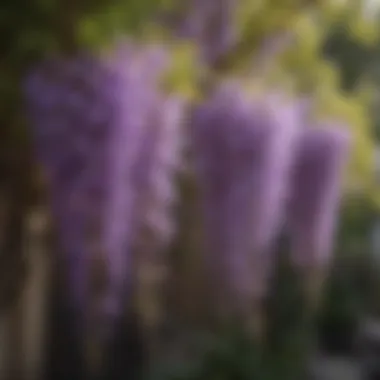Where to Find Wisteria Plants for Your Garden


Intro
Wisteria plants are celebrated for their cascading flowers and enchanting aroma. These plants add beauty and elegance to gardens and spaces. They are known for their vigorous growth and adaptability, prompting many to consider them for their own horticultural endeavors. However, acquiring a wisteria plant raises some questions about sourcing and care. This guide aims to provide detailed insights into where you can find these stunning plants and what you need to consider before introducing them into your garden.
Design Inspiration
While wisteria may primarily be seen as a garden staple, it can also inspire various design elements in your home or outdoor area. The sight of wisteria can influence the way you think about color and texture in your living space.
Current Trends in Gardening
Gardening trends have shifted towards a preference for sustainable and native plants. Wisterias, especially varieties suited to your climate, align well with this trend. They attract pollinators and promote biodiversity. The trend also inclines towards garden designs that blend functionalities, such as edible and ornamental gardens. These aspects enhance both aesthetic appeal and practical utility.
Color Schemes and Palette Ideas
The vibrant colors of wisteria flowers can dictate your garden's palette. Shades of purple and blue can contrast beautifully with greens and earth tones. When designing around these plants, consider the following color schemes:
- Complementary Colors: Pair with yellows or oranges for a vibrant display.
- Analogous Schemes: Use shades of blue and purple for a serene, cohesive look.
- Neutral Backgrounds: Whites and creams can highlight wisteria without overshadowing it.
Sourcing Wisteria Plants
Finding the right wisteria plant can be a rewarding experience. Here are some effective avenues to explore:
Local Nurseries
Visiting local nurseries can allow you to assess the health and variety of wisteria available. Experienced staff can provide valuable insights into the best varieties for your climate. Here, you can find plants suited for both cooler and warmer regions. It's also a great opportunity to examine the potting quality and root health before making a purchase.
Online Retailers
The internet provides a vast marketplace for wisteria plants. Websites like FastGrowingTrees.com and Burpee.com offer a range of options. However, when ordering online, consider the following:
- Check Reviews: Look into customer feedback to gauge quality.
- Shipping Conditions: Ensure that the plants are shipped with care to minimize stress.
- Return Policies: Familiarize yourself with the retailer's policies in case the plant does not thrive.
Alternative Methods
Consider joining local gardening clubs or community exchanges. These avenues often offer a chance to obtain cuttings or young plants from garden enthusiasts. Not only can this reduce costs, but it also fosters a sense of community.
Engaging with local gardeners can provide valuable knowledge about compatible varieties.
Essential Care Requirements
Once you obtain a wisteria plant, it's crucial to understand its care needs.
Growth Conditions
Wisterias thrive best in well-drained soil and require full sun exposure for at least six hours a day. They can adapt to a variety of soil types, but alkaline soil is often recommended for optimal growth.
Watering Needs
Watering should be regular, especially during the first year after planting. A deep watering once a week is typically sufficient, ensuring that the roots receive adequate moisture without becoming waterlogged.
Pruning Techniques
Proper pruning is vital for the health of your wisteria. The ideal time for pruning is in late winter or early spring. Remove excess growth and manage the shape of the plant to encourage flowering.
The End


Wisteria plants can transform any garden into a vibrant display of beauty. With proper care and careful sourcing, including local nurseries and online options, you can successfully integrate this lovely plant into your horticultural pursuits. Consider the environmental impacts and your local climate as you embark on this journey. This guide serves as a comprehensive resource for gardening enthusiasts and homeowners alike, offering insight into the specifics of obtaining and nurturing wisteria.
Preamble to Wisteria
Wisteria is a genus of flowering plants that is renowned for its beautiful cascading flowers and fragrant blooms. This makes it a popular choice among gardeners and homeowners looking to add elegance and charm to their landscapes. Understanding Wisteria is essential not just for aesthetic reasons, but also for practical gardening knowledge. The management of these plants requires consideration of their growth habits, care needs, and specific environmental conditions.
Gaining insight into Wisteria allows potential growers to make informed decisions about its maintenance and propagation. With a variety of species and cultivars available, knowing the differences can aid in selecting the best fit for your garden. Moreover, Wisteria's vigorous growth can be both a benefit and a challenge, highlighting the importance of responsible cultivation.
In this section, we will provide an overview of Wisteria, including its native habitats and general traits. This will lead us to an investigation into its characteristics, further enabling enthusiasts to appreciate the true nature of this captivating plant.
Overview of Wisteria
Wisteria is native to East Asia and North America. The most commonly cultivated species include Wisteria sinensis, Wisteria floribunda, and Wisteria frutescens. These species are recognized for their stunning purple to white flowers that hang in lovely clusters. Besides their visual appeal, Wisteria is also known for attracting pollinators, which contributes to a healthier garden ecosystem.
These flowering vines can reach considerable heights, making them suitable for trellises, pergolas, or large structures. They thrive in various soil types, provided there is adequate drainage and sunlight. Knowing where Wisteria comes from can help growers mimic its natural environment, ensuring healthier plants and better blooms.
Characteristics of Wisteria
Wisteria plants are characterized by their long, woody stems and distinct compound leaves. Each leaf can have up to 13 leaflets, contributing to its lush appearance. Their flowers, often seen in pendant-like racemes, bloom primarily in spring, creating a rich tapestry of color that can dramatically enliven any garden space.
In terms of growth habits, Wisteria can spread rapidly. It is essential for gardeners to be aware of its potential invasiveness. With some species capable of growing up to 10 feet in a single season, managing Wisteria’s growth is critical to prevent it from overwhelming other plants.
Moreover, Wisteria requires full sun for optimal growth and flowering. While it is adaptable to different conditions, weak blooms can result from inadequate sunlight or poor soil health. Knowing these characteristics can help gardeners cultivate thriving Wisteria plants while appreciating their beauty.
Understanding Wisteria Species
Understanding wisteria species is critical for prospective homeowners and gardening enthusiasts who wish to incorporate these stunning plants into their environments. Wisteria is known for its magnificent blooms and vigorous growth, but not all species are created equal. Knowing the different species and their particular characteristics will better inform your decision on which variety suits your landscape or garden design needs.
Common Varieties
Wisteria comes in several popular varieties, each with its own unique traits. Here are a few commonly encountered types:
- Japanese Wisteria (Wisteria floribunda): This variety is cherished for its long, cascading clusters of fragrant flowers. The blooms can be white, blue, purple, or pink, making it a colorful addition to any garden.
- Chinese Wisteria (Wisteria sinensis): Another favorite, the Chinese wisteria features shorter bunches of flowers that typically bloom earlier than the Japanese variant. It offers eye-catching lavender blooms and is often characterized by its rapid growth pattern.
- American Wisteria (Wisteria frutescens): A hardier option, American wisteria is considered less invasive than its Asian counterparts. It has smaller but equally beautiful purple flowers and is less prone to disease.
Choosing the right variety can depend on your local climate, the space available, and how much sunlight your garden receives. Each type has slightly differing requirements and traits that can influence the health and aesthetic of your garden.
Differences between Species
Recognizing the differences between wisteria species is vital in maximizing their potential in your landscape. Here are some key considerations:
- Growth Habit: Japanese wisteria tends to have a more aggressive growth tendency, suitable for larger spaces or structures needing coverage. In contrast, American wisteria grows at a moderate rate, making it ideal for smaller gardens or more controlled environments.
- Flowering Times: Depending on species, flowering times can vary significantly. For example, Chinese wisteria can be more prone to blooming earlier in spring, while Japanese varieties may bloom later in the season. This can affect seasonal design themes.
- Fragrance: The scent of the flowers also varies across species. Japanese wisteria is well-known for its intensely sweet fragrance, whereas some find the American wisteria's scent to be less potent, though still pleasant.
- Environmental Considerations: Some species, particularly the Japanese and Chinese, have shown tendencies to become invasive outside their native habitats. Thus, understanding each species' habitat preferences assists in preventing ecological disruption and maintaining a balanced garden design.
"Choosing the right wisteria species can make a significant difference in your garden's aesthetics and maintenance needs."
When embarking on your search for a wisteria plant, taking the time to research these species can ensure that you select the best fit for your growing conditions and visual preferences.
Where to Purchase Wisteria Plants
Purchasing a wisteria plant requires careful consideration. Selecting the right source for your plant can significantly influence its success in your garden. Each option presents distinct benefits and challenges. This section explores local nurseries, online retailers, and community resources, providing a diverse range of options for acquiring a wisteria plant. Understanding these avenues helps you make informed decisions, benefiting your gardening experience in the long run.
Local Nurseries and Garden Centers
Advantages of Local Sourcing
Local nurseries offer a personal touch that larger retailers simply cannot replicate. Buying from these establishments ensures that you have access to plants that are well-adapted to your specific region. This adaptation increases the chances of your wisteria thriving in your garden. One key advantage is the ability to speak directly with knowledgeable staff who can provide insights on local growing conditions and advice on care.
Additionally, local nurseries often have a selection of plants that may not be available through mass-market retailers. These unique varieties can add distinct character to your garden. However, local sources might have limited stock which can be a disadvantage if you are looking for a specific type of wisteria.


Finding Specialized Nurseries
Specialized nurseries cater specifically to the needs of certain plant types, including wisteria. These nurseries often carry an extensive range of species and cultivars, making them an excellent choice for gardeners seeking specific varieties. A key characteristic of these stores is their deep expertise, allowing them to offer tailored advice for potential buyers.
Furthermore, purchasing from specialized nurseries increases the chances of supporting sustainable practices. These nurseries often prioritize environmentally-friendly growth methods, in contrast to larger operations. However, higher prices may be a deterent for some, as specialized inputs may lead to increased costs.
Online Retailers
Popular Online Plant Stores
Online retailers provide a convenient route for purchasing wisteria plants, especially for those who may not have ready access to local nurseries. Websites like Burpee, Greenhouse Megastore, and Etsy offer an array of choices. The convenience factor makes online shopping appealing; you can find a variety of plant types, including hard-to-find wisteria species.
Moreover, buying online allows you to compare prices and read reviews to ensure you are making a sound investment. However, ensure you consider the quality of the plants and shipping conditions, as not all online retailers provide the same standard of care during transit.
Criteria for Selecting a Reliable Online Source
Choosing a reliable online source for your wisteria plant is crucial. Look for retailers with clear customer reviews and ratings. A key factor in ensuring the quality of your purchase is selecting websites that provide detailed growing information, return policies, and customer service options.
Verify the seller's reputation by exploring customer feedback on platforms like Reddit or Facebook. Reliable online sources also emphasize the proper care conditioned for delivery, such as packaging and shipping practices. Failing to take care in this selection can result in receiving unhealthy plants.
Plant Exchanges and Local Markets
Community Resources
Community resources, such as local gardening clubs or online forums, can be excellent venues for acquiring wisteria plants. These groups often host plant exchanges where members trade plants or cuttings. Such exchanges encourage local gardening communities while providing affordable ways to acquire new varieties.
Participating in these exchanges is not only economical but also builds connections with fellow gardening enthusiasts. However, there may be slight risks involved, as not all plants may come with equal assurance regarding health or species.
Benefits of Plant Swapping
Plant swapping offers a unique dynamic for acquiring wisteria plants. This process encourages sharing and sustainability, creating a culture of gardening collaboration. A principal benefit is cost-effectiveness; by exchanging plants, you avoid the financial burden associated with purchasing new ones.
Moreover, plant swapping may also yield diverse genetic material, promoting resilience within your garden. Swap events often take place in local communities, making participation accessible. However, be mindful of the source of the plants and any potential diseases or pests that could accompany swaps.
Engaging in plant exchanges cultivates community spirit and enhances biodiversity within your own garden.
Things to Consider Before Purchasing
When considering the purchase of a wisteria plant, it is crucial to think through various factors that affect its growth and sustainability. Understanding these elements helps ensure that you select a suitable plant while maximizing your chances of a thriving garden.
Before making a purchase, it's important to assess your local climate conditions, as wisterias thrive in specific environments. Recognizing the necessary space and support structures for these vigorous climbers will also play a role. Additionally, evaluating the potential environmental impacts relates to the broader ecological concerns of planting invasive species.
Climate Suitability
Understanding Hardiness Zones
Hardiness zones classify regions based on temperature extremes and climate conditions. This classification helps gardeners determine which plants will survive and thrive in their specific areas. Wisterias typically flourish in USDA hardiness zones 4 to 9, depending on the variety.
Knowing your zone is useful for choosing a wisteria that will adapt to your local conditions. It's advantageous to select plants that align with your hardiness zone. This knowledge minimizes the risk of plant failure and fosters a more sustainable gardening approach. However, misjudging the zone could lead to plants that struggle or do not survive.
Assessing Microclimates
Microclimates are small areas within larger climate zones that exhibit different climatic conditions. Factors like sun exposure, wind protection, and moisture levels can create unique growing environments. Assessing these microclimates is vital for successful wisteria cultivation.
For instance, a south-facing wall can provide warmth and protection for your plant. This represents an opportunity for wisteria to flourish, leveraging the advantages of localized climate variances. However, ignoring these subtleties can result in inadequate growth or distress in your plants.
Space and Support Needs


Wisteria plants require adequate space and support to reach their full potential. These vigorous growers can spread significantly and need sturdy structures to climb on. Arbors, trellises, or strong fences can serve as ideal supports.
When planting, consider the final size of the plant. It is essential to allow enough room for growth and potential pruning. Overcrowding the area may lead to competition for resources and hinder the plant's development, resulting in poor blooming.
Potential Environmental Impact
Invasive Species Considerations
Wisteria is classified as invasive in some regions due to its fast growth and ability to outcompete native species. Understanding this characteristic is crucial for responsible gardening. Planting wisteria can negatively affect local ecosystems by displacing native flora.
Choosing to plant invasive species often comes with ecological risks. Therefore, research local regulations and assess the long-term impact on the ecosystem before acquiring a wisteria. This contemplation is not only beneficial for your garden but also contributes positively to your environment.
Native Plant Alternatives
Considering native plants as alternatives to wisteria can provide similar aesthetic appeal without the invasive risks. Native plants are well adapted to the local environment, require less maintenance, and support local wildlife.
Alternatives like honeysuckle or climbing vines native to your area can provide the necessary aesthetics while fostering ecological balance.
In summary, take your time to consider climate, support requirements, and ecological effects before purchasing a wisteria plant. This thoughtful approach ensures better planting decisions and contributes positively toward your gardening efforts.
Caring for Your Wisteria Plant
Caring for your wisteria plant is essential for its health and growth. This climber, known for its stunning cascades of flowers, requires specific attention to thrive. Proper care ensures that the plant reaches its full potential, providing beauty to your garden or landscape. Understanding the key aspects of wisteria care can make a significant difference. This includes soil requirements, watering and fertilization, and pruning techniques.
Soil Requirements
Wisteria prefers well-draining soil that is rich in organic matter. Soil should be loamy if possible; it retains moisture while allowing excess water to drain away. The pH level should ideally be between 6.0 and 7.0. Testing your soil may help in determining how to improve it for optimal growth. If your soil is heavy clay, consider amending it with compost or peat moss to enhance drainage.
It's also important to avoid compacted soil as that can impede root growth. An ideal location for planting is one that allows the roots to spread and access necessary nutrients. You might want to incorporate mulch to help moderate soil temperature and moisture.
Watering and Fertilization
Proper watering is vital, especially when the wisteria plant is young. During the first growing season, regular watering helps establish roots. After this period, wisteria becomes somewhat drought-tolerant. However, during dry spells, deep watering is advised.
As for fertilization, it is generally recommended to use a balanced fertilizer once in early spring. This helps promote vigorous growth and flowering. Over-fertilization can lead to lush foliage at the expense of blooms, which is not desirable. So, moderation is key. A slow-release organic fertilizer can also be beneficial, giving the plant time to absorb nutrients over an extended period.
Pruning Techniques
Pruning wisteria is critical for maintaining its size and flowering. This should be done at least twice a year. The first pruning takes place in late winter or early spring before new growth begins. Remove dead or weak stems to promote healthy growth.
The second phase of pruning occurs in summer, shortly after blooming. At this time, prune the long shoots to control further growth. Aim to keep the plant tidy while encouraging more flowers in the following year. Correct pruning not only enhances the appearance but also contributes to the longevity of the plant.
"Effective pruning techniques will yield not just a healthy plant but one that bursts with blooms."
By paying attention to these care requirements, you can support the growth and health of your wisteria plant effectively. Understanding the needs of your plant will lead to beautiful displays and a thriving growth environment.
Culmination
The conclusion section serves a critical purpose in this article. It encapsulates the entire journey of understanding where to find a wisteria plant, emphasizing the value of proper sourcing and care. Wisteria plants are not just beautiful additions to any garden; they require specific conditions and considerations for successful growth. By highlighting the importance of local nurseries, online retailers, and community resources, readers can make informed decisions on where to purchase these plants.
Moreover, the article discusses necessary factors such as climate suitability and environmental impact, ensuring potential growers approach wisteria cultivation responsibly. The conclusion reinforces the idea that successful gardening extends beyond mere acquisition—it includes understanding the plant’s needs and long-term care requirements.
In summary, being well-informed increases the chance of cultivating a flourishing wisteria that enhances any landscape, thus enriching the gardening experience.
Recap of Key Points
- Sourcing Options: Local nurseries, online retailers, and plant exchanges provide diverse avenues for purchasing wisteria plants, each with distinct benefits.
- Care Requirements: Understanding the soil, watering, and pruning needs is essential for thriving wisteria.
- Environmental Considerations: Potential environmental impacts like invasiveness warrant consideration before planting, emphasizing the importance of choosing native plants where possible.
- Climate Factors: Recognizing hardiness zones and microclimates aids in selecting the right wisteria species for your garden.
Final Thoughts on Wisteria Cultivation
Consideration of the plant's needs continues beyond just the purchase. Effective care, attention to environmental impact, and adaptability to local climate conditions play vital roles in the success of your garden.
By taking these factors into account, you not only foster the growth of a beautiful plant but also contribute positively to the environment and the gardening community at large. Investing time and effort into these aspects will yield a splendid reward—an elegantly blooming wisteria that brings joy and beauty to your living space.



